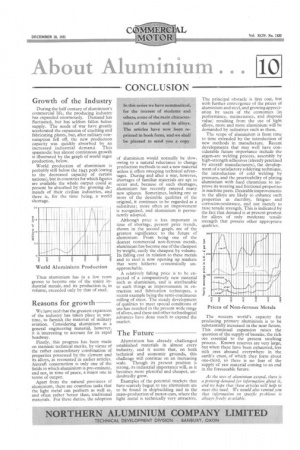About Aluminium... 10
Page 76

If you've noticed an error in this article please click here to report it so we can fix it.
CONCLUSION
Growth of the Industry
During the half century of aluminium's commercial life, the producing industry has expanded enormously. Demand has fluctuated, but has seldom fallen below supply. The needs of war have greatly accelerated the expansion of smelting and fabricating plants, but, after military consumption fell off, the new production capacity was quickly absorbed by an increased industrial demand. This spasmodic but almost continuous growth is illustrated by the graph of world ingot production, below_ World production of aluminium is probably still below the 1943 peak (owing to the decreased capacity of certain nations), but in countries for which figures are available the whole output could at present be absorbed by the growing demands of their civilian industries, and there is, for the time being, a world shortage.
Thus aluminium has in a few years grown to become one of the major industrial metals, and its production is, in volume, exceeded only by that of steel.
Reasons for growth
We have said that the greatest expansion of the industry has taken place in wartime, to furnish the material of military aviation. Considering aluminium as a general engineering material, however, it is interesting to account for its rapid headway.
Firstly, this progress has been made on intrinsic technical merits, by virtue of the rather extraordinary combination of properties possessed by the element and its alloys, as recounted in earlier articles_ Aircraft construction is only one of the fields in which aluminium is pre-eminent, and not, in time of peace, a major one in terms of output.
Apart from the natural provinces of aluminium, there are countless tasks that the light metal can perform as well as, and often rather better than, traditional materials. For these duties, the adoption of aluminium would normally be slow, owing to a natural reluctance to change production methods to suit a new material unless it offers sweeping technical advantages. During and after a war, however, shortages of familiar materials are apt to occur and, because of such shortages, aluminium has recently entered many new spheres. Sometimes, lacking one or more of the desirable qualities of the original, it continues to be regarded as a substitutes more often an improvement is recognized, and aluminium is permanently adopted.
Although price is less important in time of shortage, present price trends, shown in the second graph, are of the greatest significance to the future of aluminium. From being one of the dearest commercial non-ferrous metals, aluminium has become one of the cheapest by weight, easily the cheapest by volume. Its falling cost in relation to these metals and to steel is now opening up markets that were hitherto economically unapproachable.
A relatively falling price is to be expected of a comparatively new material such as aluminium, and is attributable to such things as improvements in extraction and fabrication techniques, a recent example being the semi-continuous rolling of sheet. The steady development of qualities to meet special conditions of use has resulted in the present wide range of alloys, and these and other technological advances have done much to expand the market.
The Future
Aluminium has already challenged established materials in almost every industry, and it seems that, on both technical and economic grounds, this challenge will continue on an increasing scale. Though its present position is strong, its industrial importance will, as it becomes more plentiful and cheaper, undoubtedly grow.
Examples of the potential markets that have scarcely begun to use aluminium are to be found in shipbuilding and in the mass-production of motor-cars, where the light metal is technically very attractive. The principal obstacle is first cost, but with further convergence of the prices of aluminium and steel, and growing appreciation by users of the economies (in performance, maintenance, and disposal value) resulting from the use of light alloys, more and more aluminium will be demanded by industries such as these.
The scope of aluminium is from time to time extended by the introduction of new methods in manufacture. Recent developments that may well have considerable future importance include the argon-arc welding process, assembly by high-strength adhesives (already practised by aircraft manufacturers), the development of a satisfactory soldering technique, the introduction of cold welding by pressure, and the practicability of plating aluminium with hard chromium to improve its wearing and frictional properties in machine parts. Desirable improvements in the alloys are likely to enhance such properties as ductility, fatigueand corrosion-resistance, and not merely to raise tensile strength. This is indicated by the fact that demand is at present greatest for alloys of only moderate tensile strength that possess other appropriate qualities.
The western world's capacity for producing primary aluminium is to be substantially increased in the near future. This continual expansion raises the question of the supply of bauxite, the rich ore essential to the present smelting process. Known reserves are very large, but when these have been exhausted, less rich ores abound everywhere in the earth's crust, of which they form about one-third, so there is no fear of the supply of raw material coming to an end in the foreseeable future.
As the uses of aluminium extend, there is a growing demand for information about it, and we hope that these articles will help to meet this need. We would also remind you that information on specific problems is always freely available.












































































